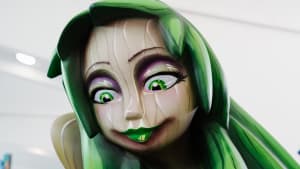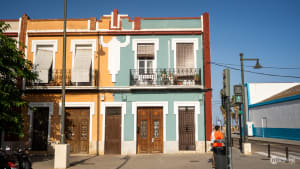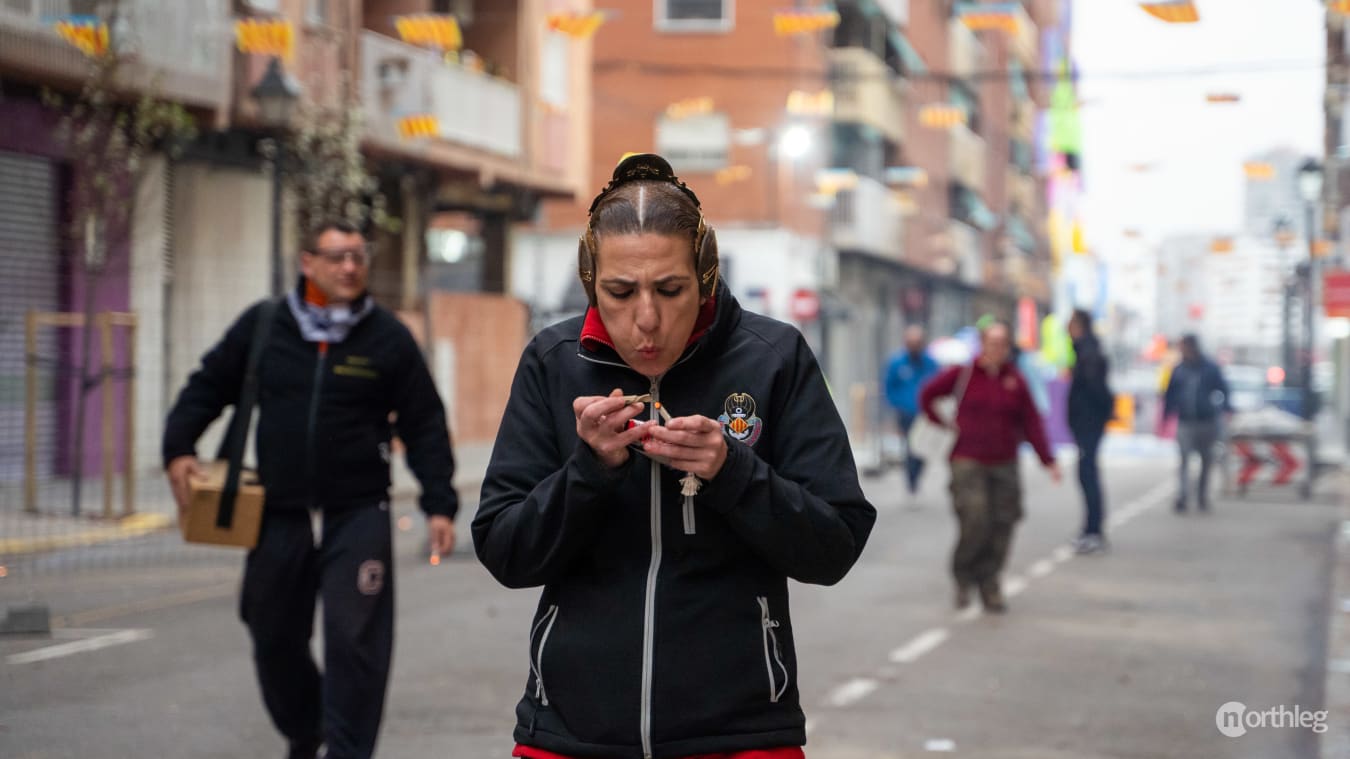
Despertà
A thundering, electrifying parade of popping firecrackers and upbeat marching band music. This is how Valencia wakes up during Fallas.
Despertà in a nutshell…
The Despertà is a thunderous morning tradition during Fallas, where falleros and falleras parade through Valencia, setting off firecrackers and marching to the beat of brass bands.
Location: Throughout Valencia’s streets, with the final gathering at Plaza del Ayuntamiento.
Time: The Macrodespertà takes place on the last Sunday of February at 7:30 AM, announcing the start of Fallas. From March 16 to 19, the daily Despertà happens at 8:00 AM, marking the most intense days of the festival.
Entry: Free, but expect loud explosions—sleeping in is not an option!
Fallas is known to be a loud, explosive festival, and the Despertà is there to remind you of this as the final days of the festival approach. In fact, the whole point of the Despertà is to announce that Fallas season has come and to keep the festive spirit high.
The Despertà, which we can translate as the “wake-up call”, is the tradition of waking Valencia up by making as much noise as possible. The falleros and falleras (both children and adults) achieve this by setting off extremely loud firecrackers every morning just after sunrise, as they parade in the streets. This makes the event one of the most beloved traditions - by those who partake in it - and one of the most despised - by those who are only witness to it.
The Despertà is celebrated on two occasions. One is to announce the arrival of the Fallas, at the end of February. The other one, between the 16th and the 19th of March, is to remind Valencia that the final, most intense days of the festival have come.
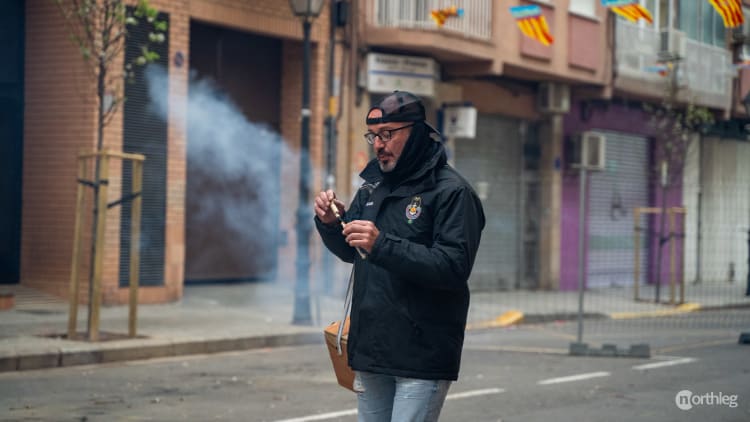
This tradition contributes to that undefinable atmosphere of excitement and expectation that permeates Valencia during Fallas. In the pale light of the morning, as the early spring air is still chilly and crisp, falleras and falleros parade together in a joyful act. Their collective laughter and excitement as the firecrackers explode are contagious. The onlookers cannot help but feel a sense of trepidation for the collaborative act that is Fallas.
If you’d like to know more about other festival events and when they are programmed for, you can check out our Fallas calendar article.
The Types of Despertàs
Fallas is a festival to be relentlessly celebrated, and that doesn’t go well with sleeping in. So the committees and their members organise the Despertàs to make sure the city doesn’t miss even the smallest opportunity to celebrate the festival.
This means that early in the morning, hundreds of falleras and falleros will parade around the city, followed by marching bands and exploding, loud firecrackers.
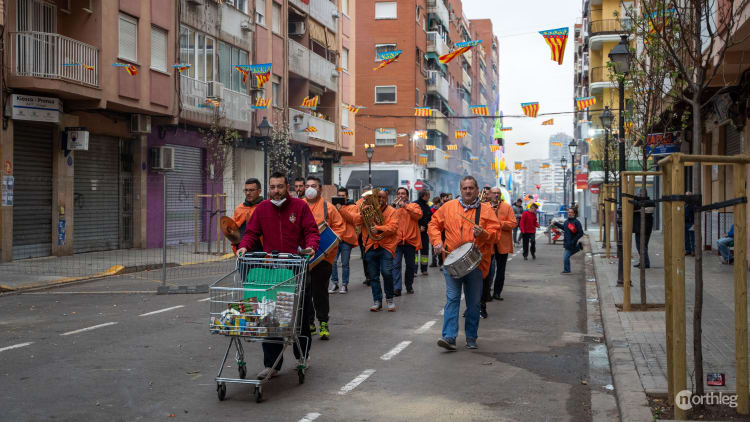
Despertà General
This is how Valencia is woken up every morning at 8:00 am between the 16th and the 19th of March. These despertàs announce that the final, most exciting and most eventful days of Fallas have finally come. The Plantà has taken place the night before, and the people can finally come out in the streets and see their city populated by the towering and colourful fallas.
These days, some might still struggle to get up, especially if they have been partying all night, but the despertà surely makes it hard to stay in bed. An atmosphere of trepidation and camaraderie pervades the city. As the Despertà’s parade comes to its conclusion, the smell of sweet fried pastries and chocolate fills the air.
Fallas committees often organise a xocolatà, a filling Valencian breakfast for the participating members. The meal normally includes dense hot chocolate and buñuelos de calabaza or ensaimadas.
Of course not all falleras and falleros attend these events, as they might stay up late at night, involved in other Fallas events. The Fallera Mayor*,* however, always attends the Despertà.
Macrodespertà
The Macrodespertà, sometimes called Macrodespertà mayor, is the first despertà of the year. This loud wake-up call on the last Sunday of February lets the entire city know that the Fallas festival is about to start.
On the day of the Fallas proclamation (the Crida), Valencia is woken up at 7:30 am by the sounds of firecrackers, marching bands, and hundreds of falleras and falleros walking their route through the city.
Early in the morning, the Fallas committee members who will parade gather at the San Juan del Hospitalet church for a homage to Saint Barbara - the patron saint of explosive handlers.

After this, the Fallera Mayor and the Fallera Mayor Infantil, together with their Cortes de Honor, start the parade. The route will include Calle de la Paz and end in Plaza del Ayuntamiento for the Disparà.
To sign up for these events, the falleros and falleras must have presented their firework licences to the Junta Central Fallera. On the day, they also need to display their permits to handle such explosives.
Despertà Infantil
The Despertà Infantil is basically the same thing as the adults’ event, with the only difference being that it is children that parade in the city. The children’s parade normally starts just ten or fifteen minutes before the adults’ one. Sometimes, the children’s event on the last Sunday of February is also called Microdespertà.
The young falleras and falleros are usually less loud than the adults because they are technically not allowed to use the trons de bac until they’re 16. Instead, they use less powerful and less noisy firecrackers, along with bombetas, the smallest and most harmless type of firecracker.
Disparà
This is a large pyrotechnic display that follows the Macrodespertà. After hundreds of Fallas committee members, both adults and kids, have walked this loud, exhilarating parade, they all gather in Plaza del Ayuntamiento for the final act, the Disparà (from disparar, to shoot). This is the final, thundering firework display that is sure to wake up even the heavy sleepers all over the city.
Although the display is very loud and similar to the Mascletà, it has lower quantities of explosives, and it is thus less aggressive. To finish off, the participating falleras and falleros are offered breakfast. This usually consists of hot chocolate and buñuelos de calabaza or ensaimadas.
Firecrackers
The defining feature of the Despertà is the noise in the streets, produced mostly by the firecrackers and - to a lesser extent - by the marching bands. As you probably already know, Valencians are great lovers of all kinds of pyrotechnics.
The louder and more sensational, the better. Here are the different kinds you’ll hear being used in the streets during a Despertà.
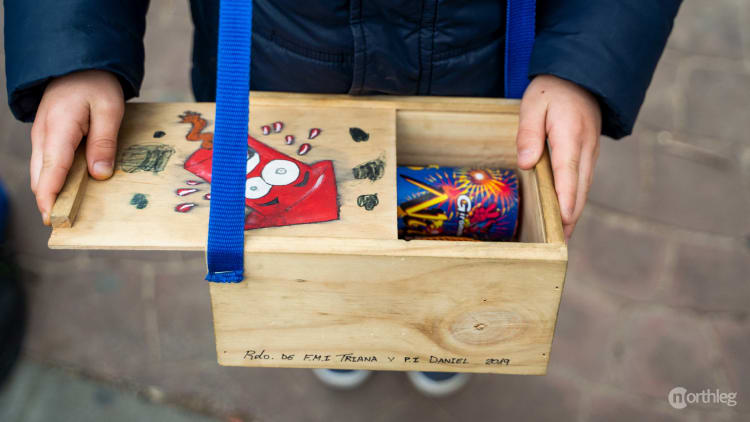
Tro de Bac
Tro de bac is the name of the firecracker typically used during the Despertà by adult falleros and falleras. It is a hand-made and extremely loud device that has no wick. Instead, to set it off, one must throw it against the ground forcefully. These are the kinds of firecrackers you don’t want to get too close to when they explode.
It is said that the origin of the tro de bac is related to Valencia’s stonemasons. The workers used explosive devices and gunpowder products to break large blocks of stone. Over time, the leftovers from these activities started being used recreationally. These primitive trons de bac were especially enjoyed by the younger members of the community.
It so became a tradition to set off these devices in the early hours of a festive day, around dawn, to wake the city up for the celebration. The first recorded commercial trons de bac in Valencia were sold in 1902-1903 in small boxes.
Around the 2010s, trons de bac came close to disappearing because of the strict EU laws that regulated their use and production. However, local interest kept the tradition afloat, and nowadays the production seems to be increasing again.
The firecrackers are still produced locally and only according to demand. To purchase them, you have to get a special license called Curso CRE, which requires attending a course and passing an exam.
Bombetas
For the Despertà Infantil, smaller firecrackers - bombetas - are normally used. They are the smallest type of firecrackers, like Pop Its or Party Snaps.
Bombetas belong to a class of pyrotechnic devices allowed to kids as young as 8 years of age. However, Valencian passion for firecrackers starts early, and it is not uncommon, under Fallas, to see children of even 3 years of age set bombetas off.
Schedule
The programme for the Despertàs can vary every year, but it normally follows this schedule.
| Event |
|---|
| Last Sunday in February |
| 16th - 19th March |
Remember that the Despertà is not a single-venue event. The falleros and falleras walk all around Valencia setting off their firecrackers.
Frequently Asked Questions
Here you can find quick answers to all of your questions. Linked, you’ll find the articles or the sections of the articles that can give you more detailed information.
-
The Despertà is a traditional morning parade whose aim is to wake Valencia up by setting off extremely loud firecrackers all over the city’s streets.
-
Falleras and falleros, both adults and children, can participate and parade in the Despertà.
-
The first Despertà of the year (last Sunday of February) is at 7:30 am. The other Despertàs in March (16th to 19th) are at 8:00 am.
-
The Despertàs all take place around Fallas time. The first of the year is on the day of the Cridà, the last Sunday of February.
After that, the last four days of Fallas - 16th to 19th of March - also have their own Despertàs.
-
The point of the Despertà is to remind everyone that Fallas time has come, and to make sure that everyone makes the most of the festival by not sleeping in. In other words, the point is to wake everyone up so that they can celebrate more.
-
Like most other events under Fallas, it is very loud. The Macrodespertà (adults’ parade) is louder than the Despertà Infantil (children’s parade) because of the types of fireworks used.
However, if you are far from the city centre, you might not be affected by the noise.
-
The Macrodespertà is the first parade of the year, on the last Sunday of February. Sometimes it is also called Macrodespertà mayor, to indicate that the term refers to the adult falleras and falleros parade.
-
A Despertà Infantil is a morning parade where it is children - instead of adults - who walk the streets and throw firecrackers.
-
The Microdespertà is the first children’s parade of the year, on the last Sunday of February.
-
They are both morning parades on the last Sunday of February. One (the Macrodespertà) is led by adults and the other (the Microdespertà) is led by children.



